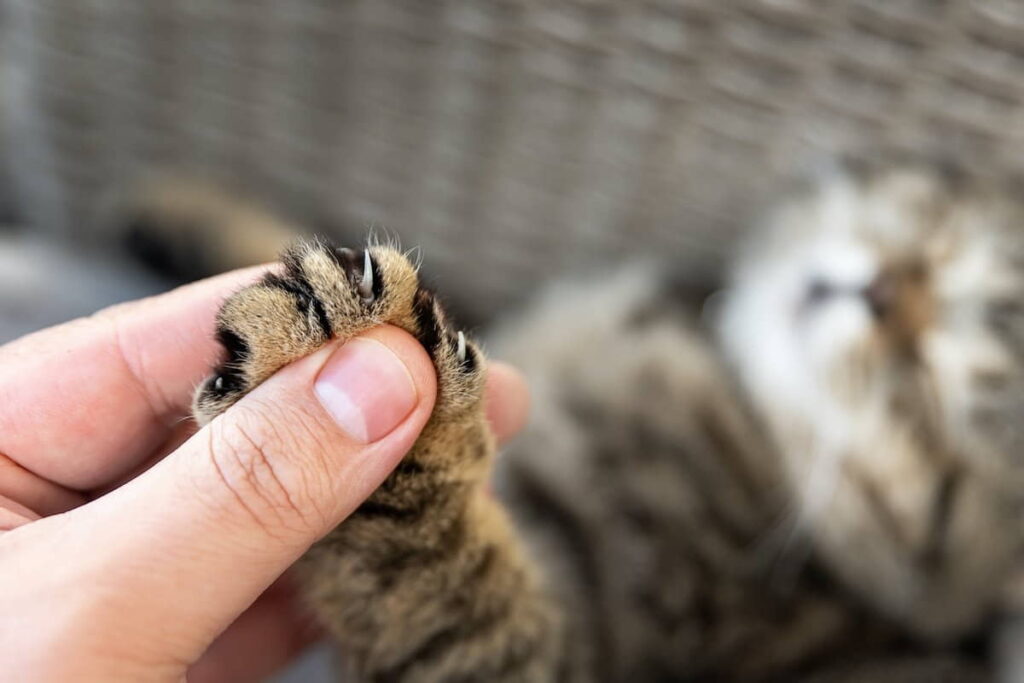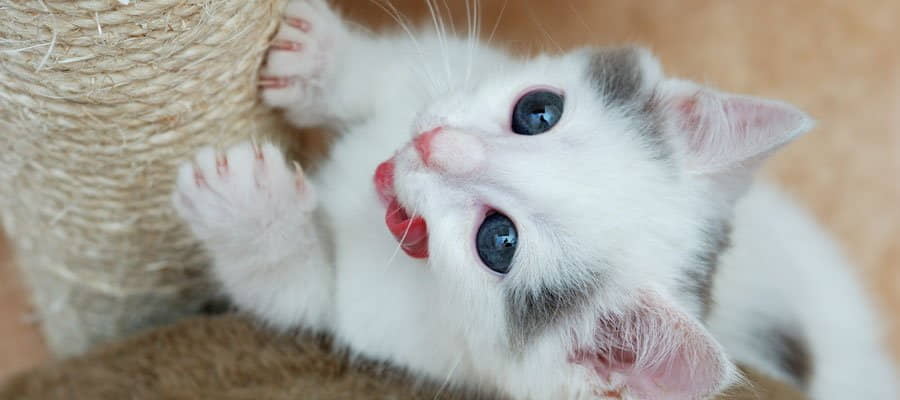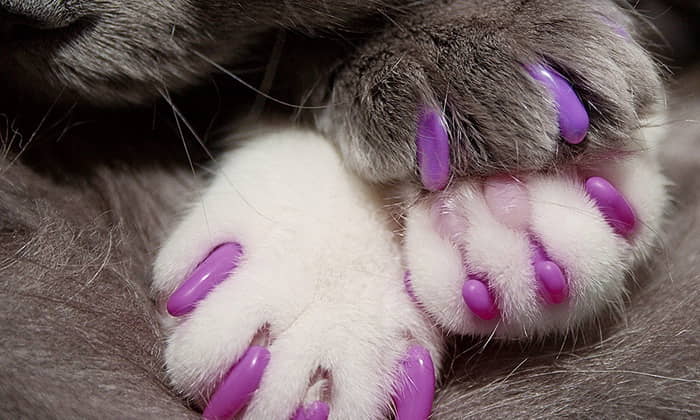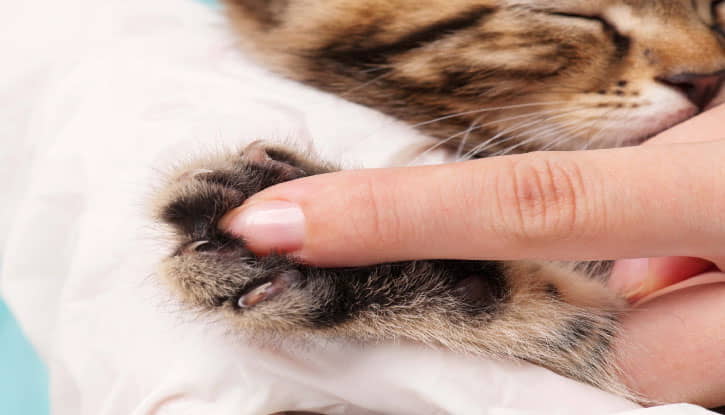The American Society for the Prevention of Cruelty to Animals and the ASPCA’s Bergh Memorial Hospital encourage owners to seek alternatives to cat declawing. If you are thinking about declawing your cats, please take a moment to consider the following information.
Claws Are Important To A Cat
A cat’s remarkable grace and agility and its faultless sense of balance are due to a great extent to its retractable claws, which allow it to establish footing for walking, running, springing, climbing, or stretching. A cat’s claws are also its best defense mechanism.

The Need To Scratch
When a cat scratches, it pulls off the old outer nail sheath and exposes sharp, smooth claws. Scratching is also a way of fulfilling the cat’s strong instinctive need to mark its territory. Not only does a cat mark an object visibly by scratching it, but the scratching deposits secretions from glands in the feet that can be smelled by other cats. Scratching may also serve psychological and physiological needs by providing comfort and expression by kneading and allowing valuable stretching and foot-muscle exercise.

Declawing Operation
The standard declawing procedure calls for the removal of the claw, and the last bone of the toe. The operation is usually performed on the front feet. It is actually an amputation comparable to the removal of the fingers of the human hand at the last knuckle. The cat experiences considerable pain in the recovery and healing process.
Cons of Declawing Cats
Medical: As with any surgical procedure that requires general anesthesia there are risks. Complications from anesthesia and/or the surgical procedure are possible. The use of advanced anesthetics, proper monitoring of the anesthetized patient and surgery performed by a qualified veterinarian should limit the risks substantially.
Occasionally, cats may develop chronic problems following declaw surgery. Sometimes an infection is present or a bit of surgical glue has not properly extruded and must be removed. If a portion of the bone remains, it can cause a very painful condition and recurrent infections and must be removed surgically. If the toes are not comfortable, the cat seems to be “walking on eggshells” after the recovery period should have been over, or the cat seems irritable about hcan be feet, a checkup is warranted.

Behavioral: Although no definitive studies have been conducted on the effects of declawing, owners and veterinarians have noticed personality changes in some declawed cats. Formerly lively, friendly animals have got become withdrawn and introverted. Others, deprived of their primary form of defense, become nervous, fearful, and/or aggressive, often using their only remaining defense, their teeth. At the same time, the favorite furniture scratching area can end up being made less attractive by contact paper sticky side out (held on with upholstery screws).
Safety: A declawed cat must never be allowed outdoors; its ability to defend itself or escape from danger has been seriously impaired. Even indoors, a cat without claws faces dangers. One physical effect of declawing is a gradual weakening of the muscles of the legs, shoulders and back; balance is impaired. This, combined with the fact that despite its grace, a cat’s surefootedness depends on its ability to grasp quickly with its claws, means that a declawed animal can more easily be injured in a fall.
Cat Declawing Alternatives
Introduce A Scratching Post: Buy or make a scratching post that is tall enough so the cat can stretch completely when scratching, and stable enough so it won’t wobble when being used. It should be covered with a heavy, rough fiber like sisal or the back side of carpeting. Place the post in an accessible area. Make it a fun place to be.
Train with a duthel approach: discourage the cat from clawing the wrong things, encourage the cat to claw the right things. If the cat begins to scratch the furniture, call him by name, firmly telling him “no”, and entice him over to the scratching post with a ribbon or fresh catnip. Each time he goes on his own, praise him, pet him, and spend a minute playing at the write-up. If you are trying to discourage the cat from scratching a particular piece of furniture, try placing the post in front of it, gradually moving the publish aside as the cat begins to use it regularly. The constant state of stress caused by a feeling of defenselessness may make some declawed cats more prone to disease or to inappropriate elimination outside the litterbox. Put inexpensive cardboard scratch pads or posts near all the cat’s favorite furniture.

Keep The Cat’s Nails Trimmed: cutting the nails regularly may help a cat from scratching the furniture, or at least reduce the damage done by his scratching. Get your kitten used to having his nails clipped while he’s young. With an older cat, it may help to begin by handling the cat’s feet under pleasurable circumstances. Then begin to introduce the clipping procedure by approaching the cat while he’s relaxed or even napping and clip only a few nails per session. Praise your cat while you clip the nail and reward him with a treat.
If you’re in doubt about what the proper nail length looks like, have your veterinarian trim the nails once. The only equipment necessary is a great pair of feline nail scissors. Before cutting, look for the pink “quick” that runs down the center of the nail. The scissors should cut about an eighth of an inch forward of the quick. Be extremely careful not to cut into the quick. If this happens, the cat will experience pain, and bleeding is likely. The bleeding may stop without assistance, or you may need to hold a soft cloth on the nail or apply a little styptic powder. If you trim a small amount of nail on a regular basis, the quick will actually tend to recede.
Is Your Cat Scratching You?
It is not uncommon to get scratched by your kitten or adolescent cat. It is during these growth stages that predatory play is at its highest. To avoid being seen as “prey” by your cat, direct play onto such interactive toys as a catnip mouse on a string or commercially available toys like the Cat Dancer or Kitty Tease. If your cat will be still pouncing on fingers and toes, reprimand it with a loud open-mouthed hiss or a puff of air blown in the face.
Scratching is natural and satisfying for cats, and you it owe to your kitty to teach him to scratch in appropriate places. Your veterinarian can help you prevent or redirect scratching behaviors too.
The ASPCA hopes that you will give careful consideration to the decision to declaw or never to declaw your cat. It is a painful procedure that can have serious physical and behavioral consequences for your pet. If you have questions about declawing or about training your cat, don’t hesitate to call us. We’ll do our best to help you establish and maintain a happy relationship with your feline friend, while keeping both your furnishings and your performg in one piece.
If you are certain that you want a declawed cat, you can adopt a cat who has already been declawed. You may also search Catfoodsite specifically for declawed cats. If you do adopt a declawed cat, remember that, while it’s safest for all cats to be kept indoors, it’s essential for declawed cats: Without his claws, a cat is less able to defend himself against dogs and other dangers, and has a harder time climbing to safety if attacked.
Wondering about Get Your Cat to Like His Carrier? Check it out on our latest post!


0 Comments